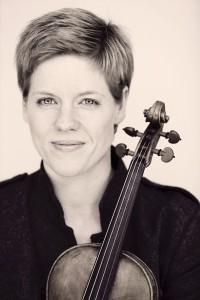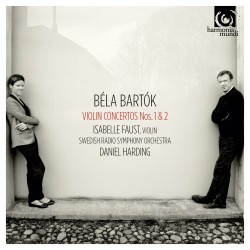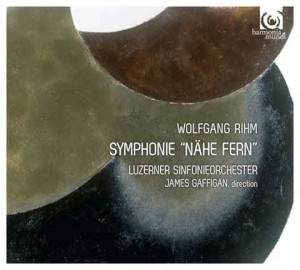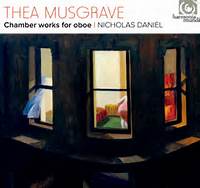CD Reviews: Isabelle Faust plays Bartók; Wolfgang Rihm’s Symphonie “Nähe fern”; Tokyo String Quartet plays Dvorak and Smetana; Thea Musgrave’s Chamber Works for Oboe (Harmonia Mundi)
A round-up review of new releases from Harmonia Mundi—an invigorating crop of albums.
By Jonathan Blumhofer.
Violinist Isabelle Faust has been busy, of late, building an impressive discography covering both familiar and lesser-known repertoire. Coming on the heels of last year’s critically praised recording of the Beethoven and Berg concertos with Claudio Abbado and the Orchestra Mozart is a stellar new release of the two violin concertos of Belà Bartók. Though there are already many fine recordings of these pieces on the market, Faust’s account, recorded with Daniel Harding and the Swedish Radio Symphony Orchestra (SRSO), is compelling and not one to be missed.
The first concerto, written during Bartók’s ill-fated romance with the violinist Steffi Geyer in 1907–08 and unpublished during it’s composer’s lifetime, receives a performance here that’s simply ravishing. The first movement has rarely sounded sweeter or more poetic than it does in Faust’s hands, as she conjures up delicate wisps of sound that seem to hang in the air as they eventually find their way into this unusually (for Bartók) Romantic essay. The warmth of her playing carries over into the more rustic second movement, where it’s paired with folksy grit and characterful humor. Faust’s playing is distinctively personal: throughout this album, there’s the strong sense that she’s very much at home with herself and this music, and she clearly has something to say about it.
That fact is even clearer in her performance of the Violin Concerto no. 2 (1938), and this recording incorporates Bartók’s original ending of the piece (which omits the solo violin over the last several pages of the score). This is one of the most formidably complex and virtuosic concerti in the repertoire, though Faust rarely lets its demands sound difficult: the whole piece comes across as brilliantly impressive, whether she’s navigating microtones, folk dance idioms, or double-stop trills. Simply put, this is one thrilling ride, especially with the wild brass glissandos that close the piece (Faust’s liner notes liken the effect to “the roaring of elephants,” an apt description).
Harding draws some wonderful, sensitive playing from the SRSO in the first concerto—check out the aforementioned opening of the first movement for some exquisite weaving of melodic threads—as well as in the album’s second work, which allows the orchestra a bit more of a symphonic presence. This is an orchestra that’s done some fine accompanimental work in the last few years (most notably on Hilary Hahn’s Schoenberg/Sibelius album with Esa-Pekka Salonen); this disc makes one want to hear them alone in some Bartók (and much else).
*****
Wolfgang Rihm’s Symphonie “Nähe fern” receives its premiere recording, courtesy of the Luzerner Sinfonieorchester and James Gaffigan. Rihm isn’t as widely known in the United States as he is in Europe (he is generally considered Germany’s leading contemporary composer), but he’s terrifically prolific and something of a stylistic chameleon, his music extending the expressionist tradition of Mahler and Schoenberg by infusing it with the influence of contemporary composers like Luigi Nono and Helmut Lachenmann, among others.
Symphonie “Nähe fern” (the title translates as “proximate distance”) is a twenty-first-century response to the Brahms symphonies, each of its four movements corresponding to a specific Brahms opus. Compositionally, it’s an intriguing conceit that, impressively, results in some deeply haunting music. Echoes of Brahms—and not just Brahms, but some of the early music Brahms admired—finds its way into a tapestry of sound at once familiar and unique. And the credit for its success must go to Rihm, who takes on the shadow of one of Germany’s greatest composer and doesn’t blink, his formidable compositional technique a wonder to behold; no anxiety of influence here.
Even so, it takes a little while for the piece to get going. The long, brooding first movement makes for a rather stark introduction, though it builds to some tremendous, Mahlerian climaxes. References to the Brahms symphonies become more specific in the three subsequent movements, especially the second and fourth with their deliberate quotations, though there’s no mistaking this Symphonie as some sort of pastiche, so well-integrated into Rihm’s musical language are the Brahms quotes. Throughout, the orchestral writing is never short of expert, and it’s delivered with a focus and attention to detail by the Luzerner Sinfonieorchester that should be a model for all large ensembles handling complex, contemporary scores: Gaffigan and the orchestra clearly believe in this music and their commitment is strongly conveyed in their performance.
Interspersed among the instrumental movements is an orchestration of Rihm’s setting of Goethe’s “Dämmrung senkte sich von oben,” from which the Symphonie draws its title (coincidentally, it’s also a text that Brahms set). It’s a lied that matches the overall autumnal ethos of the larger work, though baritone Hans Christoph Begemann’s tone is a bit strained and forced in his upper register.
*****
The 2012–13 season marked the last for the storied Tokyo String Quartet (TSQ) who, after 40 years, culminated their significant recorded legacy with a new release of popular quartets by Dvořák and Smetana. Both pieces on this disc—Dvořák’s F major Quartet (“American”) and Smetana’s Quartet in E minor (“From My Life”)—are well documented on disc, and this recording doesn’t radically reinterpret either. What it does present is superior playing from an ensemble going out at the top of its game: not only is there great depth to the TSQ’s reading of both scores, but nothing is routine or relaxed.
Both quartets are filled with great tunes and the rhythms Czech folk music (though Dvořák’s was written in, of all places, Iowa). The TSQ’s Dvořák gets a symphonic treatment with two big-boned opening movements; the slow second feels particularly nostalgic, especially in the impassioned cello solos powerfully rendered by Clive Greensmith. The lithe third trips along gaily, while the TSQ’s vigorous finale marries triumph with the touch of sadness that makes this piece so unforgettable.
Smetana’s E minor Quartet is given an equally magisterial account. Violist Kazuhide Isomura’s opening solos breathe a contagious fire that the rest of the ensemble feeds off of all the way through to the grim pages of the finale. Of particular note is the rambunctious second movement, with its obsessive, displaced rhythms and weird turns of harmony: the TSQ’s performance is (somehow) delightfully harrowing.
This is an ensemble that has pulled off the feat of calling it a day while leaving us wanting more. They’ll be missed, but, thankfully, they leave behind a tremendous catalogue that ensures they won’t be forgotten.
*****
Now 85, Thea Musgrave has been one of the busiest composers of the last half of the twentieth century (and, now, the beginning of the twenty-first), writing for just about every conceivable combination of instruments and genres. Musgrave’s chamber music for oboe is the subject of Nicholas Daniel’s eponymous new album, which covers works written since 1960.
With such a wide time period as his focus, Daniel’s disc (on which he’s joined by members of the Chilingirian Quartet) traces some fascinating stylistic developments in Musgrave’s writing. There’s a pensive account of the 1960 Trio for oboe, flute, and piano, an engrossing study in textures and balances; a dynamic, eerie performance of the futuristic Niobe (1987) for oboe and tape; and a wonderfully characterful interpretation of Night Windows (2007), a set of miniatures for oboe and piano.
Perhaps the best piece on the album is 2008’s Cantilena, for oboe, violin, viola, and cello. In it, Musgrave created some music that’s simply beautiful and the blend of instruments—oboe and strings—feels utterly natural. Two Impromptus (dating from 1967 and 1970, respectively) and a moving Threnody (1997/2005) for English horn and piano round out the disc.
One can only hope that this new album brings Musgrave wider popular recognition. It’s hard to imagine better performances of these pieces, and, for fans of contemporary chamber music especially, this is a very welcome addition to the discography.
Tagged: CD, Harmonia Mundi, Isabelle Faust, Nicholas Daniel, Symphonie “Nähe fern”, Thea Musgrave, Tokyo String Quartet





